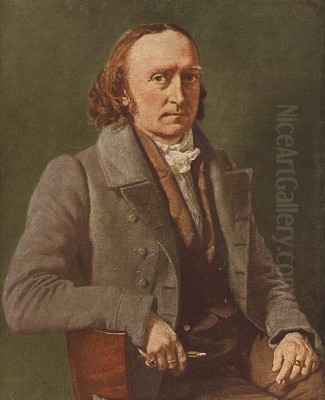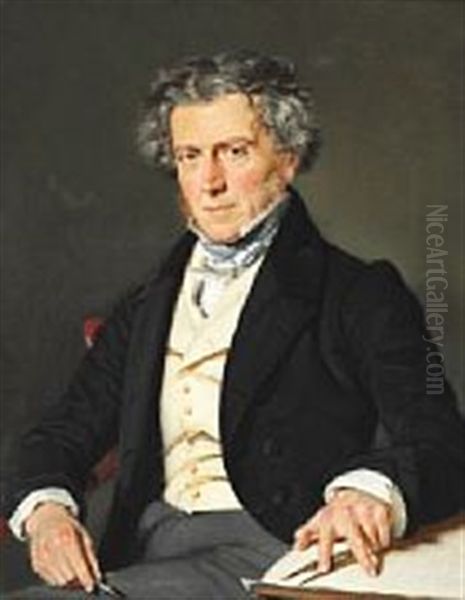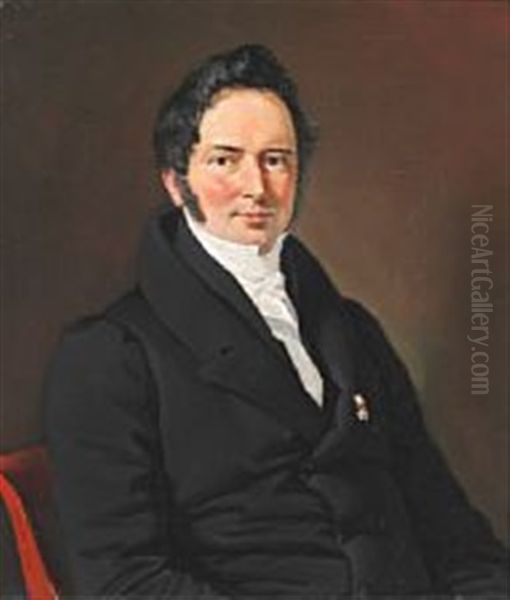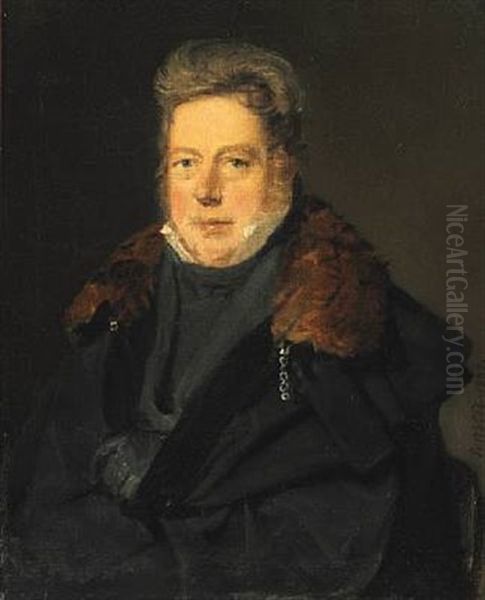
Christian Albrecht Jensen stands as a significant figure in the annals of Danish art, a master portraitist whose canvases captured the likenesses and, more profoundly, the essence of the leading personalities of his era. Active during the flourishing period known as the Danish Golden Age, Jensen's work provides an invaluable visual chronicle of 19th-century Denmark, reflecting its cultural vibrancy, intellectual fervor, and the distinct character of its people. His meticulous technique, combined with a keen psychological insight, allowed him to create portraits that were not only accurate representations but also compelling works of art that continue to resonate with viewers today.
Early Life and Artistic Awakening
Born on June 26, 1792, in Bredstedt, a town in the Duchy of Schleswig, then under Danish rule, Christian Albrecht Jensen's artistic inclinations emerged early. The region, with its mixed Danish and German cultural influences, may have subtly shaped his developing worldview. His formative years set the stage for a career that would see him become one of Denmark's most sought-after portrait painters. Like many aspiring artists of his time, the allure of Copenhagen, the kingdom's cultural and artistic heart, proved irresistible.
Jensen's formal artistic education began at the Royal Danish Academy of Fine Arts in Copenhagen. This institution, founded in 1754, was the crucible for many talents of the Danish Golden Age. Here, he would have been exposed to the prevailing Neoclassical ideals, championed by figures like Nicolai Abildgaard, a predecessor whose historical paintings and strong academic influence shaped a generation. While Abildgaard had passed away before Jensen's prime, his legacy and the academic traditions he fostered were still palpable. Jensen's training would have emphasized rigorous drawing, anatomical study, and the copying of classical sculptures and Old Master paintings, a standard curriculum designed to instill discipline and a respect for tradition.
The Italian Sojourn: A Crucible of Influence

A pivotal chapter in Jensen's development was his journey to Italy, a near-obligatory pilgrimage for ambitious Northern European artists. From 1817 to 1821, he immersed himself in the artistic riches of Rome. This period was crucial not merely for the opportunity to study masterpieces of antiquity and the Renaissance firsthand, but also for the vibrant international community of artists he encountered. Italy, particularly Rome, was a melting pot where artists from across Europe exchanged ideas and honed their skills.
During his time in Rome, Jensen came into the orbit of the celebrated Danish sculptor Bertel Thorvaldsen. Thorvaldsen, a towering figure of Neoclassicism, was an international celebrity whose studio was a focal point for artists and patrons. While Jensen was a painter and Thorvaldsen a sculptor, the latter's emphasis on clarity of form, idealized beauty, and profound understanding of classical art undoubtedly left an impression on the young painter. Jensen is often described as having been a student of Thorvaldsen, which likely refers more to a mentorship and influence within Thorvaldsen's circle rather than formal tutelage in painting. The intellectual and artistic atmosphere around Thorvaldsen would have been immensely stimulating.
In Rome, Jensen also encountered other artists, including the Italian painter known as Brøndsted, whose portrait he painted. This interaction highlights the cross-cultural exchanges that characterized the Roman art scene. He would have seen the works of contemporary Italian painters, as well as those by French artists like Jean-Auguste-Dominique Ingres, whose meticulous portraiture and classical sensibilities were gaining prominence. The experience of Italy, with its rich artistic heritage and dynamic contemporary scene, broadened Jensen's horizons and refined his technique. He produced works during this period, such as the 1819 portrait of Rudolf Bay, painted on copper, showcasing his developing style.
Return to Denmark and Ascendancy in Portraiture
Upon his return to Denmark, Christian Albrecht Jensen quickly established himself as a leading portrait painter. The Danish Golden Age was in full swing, a period marked by a surge in national pride and cultural achievement, despite political and economic challenges. There was a growing bourgeois class and an intellectual elite eager to have their likenesses preserved, providing ample commissions for a skilled portraitist. Jensen's ability to capture not just a physical resemblance but also the sitter's character and social standing made him particularly sought after.

His studio became a hub for prominent figures from various walks of life: artists, writers, scientists, politicians, and merchants. He developed a reputation for his efficient working method, often preferring smaller canvas sizes. This practice, which he shared with some French contemporaries, had the practical advantage of reducing the lengthy and often tedious sitting times for his subjects, making the experience more agreeable and perhaps contributing to the naturalness he often achieved in his depictions. Over his career, Jensen is credited with painting over 400 portraits, a testament to his productivity and popularity.
The Quintessential Portraitist: Style and Technique
Christian Albrecht Jensen's artistic style is characterized by its meticulous realism, fine brushwork, and a often cool, subdued palette. He paid scrupulous attention to detail, rendering textures of fabric, the nuances of facial features, and the subtle play of light with remarkable precision. However, his work transcends mere photographic accuracy. Jensen possessed a keen ability to delve into the psychology of his sitters, conveying their personality, intellect, or emotional state through subtle cues in expression, posture, and gaze.
His compositions are typically straightforward and uncluttered, focusing intently on the subject. Backgrounds are often kept simple, sometimes a neutral tone or a minimally suggested interior, ensuring that nothing distracts from the sitter. This directness lends an immediacy and intimacy to his portraits. While his palette could be cool, it was capable of great subtlety and harmony, and he masterfully handled light and shadow to model form and create a sense of three-dimensionality.
Jensen's approach can be seen as an inheritor of the Northern European tradition of portraiture, which valued verisimilitude and psychological depth, reminiscent of some aspects of the Dutch Golden Age masters like Rembrandt van Rijn or Frans Hals in their ability to capture character, though Jensen's style was more polished and less overtly painterly than Hals. He absorbed these influences and melded them with the Neoclassical emphasis on clarity and order prevalent in his formative years, as well as the burgeoning Romantic sensibility that valued individual expression.
Notable Sitters and Masterpieces
Among Jensen's most celebrated works are his portraits of key figures of the Danish Golden Age. His 1836 portrait of the writer Hans Christian Andersen is iconic. It captures the young author with a sensitive, almost vulnerable expression, hinting at the imaginative depth and perhaps the underlying melancholy that characterized the famed storyteller. The painting is more than a likeness; it is an interpretation of a complex artistic personality.

Another significant work is his portrait of Carl Friedrich Gauss, the renowned German mathematician and physicist, painted in 1840. This depiction of Gauss in his later years, with a penetrating gaze and an air of profound intellect, became the definitive image of the scientist. The portrait was displayed at the Pulkovo Observatory in St. Petersburg and was widely reproduced, even appearing on currency and postage stamps, cementing its status as a key representation of one of history's greatest scientific minds.
Jensen also painted his fellow artists, including Christoffer Wilhelm Eckersberg, often considered the "Father of the Danish Golden Age." Portraying such a prominent figure within the artistic community underscores Jensen's own standing. His portrait of the sculptor Bertel Thorvaldsen further links him to the leading artistic forces of the era. Other notable subjects included the theologian and philosopher N.F.S. Grundtvig, a pivotal figure in Danish national identity, and the politician Anders Sandø Ørsted. Each portrait offers a window into the individual and the society they inhabited.
His portrait of the British architect and painter Charles Robert Cockerell, with whom he reportedly collaborated, demonstrates his connections beyond Denmark. These works, taken together, form a gallery of the intellectual and cultural elite of early to mid-19th century Northern Europe.
Broader Artistic Interests: Landscapes and Still Lifes
While primarily celebrated for his portraiture, Christian Albrecht Jensen also ventured into other genres, including landscape and still life painting. His engagement with these subjects, though less central to his oeuvre, reveals a broader artistic sensibility. His landscapes, likely influenced by his time in Italy and the prevailing Romantic interest in nature, would have allowed for a different mode of expression, perhaps focusing more on atmosphere and the picturesque.
His still life paintings are particularly interesting in the context of his relationship with Bertel Thorvaldsen. It is recorded that during a later stay in Rome (1833-1835), Thorvaldsen lent Jensen items from his extensive collection of antiquities to use as subjects for still life compositions. This practice not only provided Jensen with intriguing subject matter but also connected him directly to the classical past that so fascinated the Neoclassical artists. These still lifes would have been exercises in composition, texture, and the play of light on varied objects, further honing the skills so evident in his portrait work.
The Collector and Connoisseur
Beyond his own artistic production, Christian Albrecht Jensen was also a collector of art. He amassed a personal collection of paintings, drawings, and prints, including works by Old Masters. This activity was not uncommon among artists, who often studied and drew inspiration from the works of their predecessors. Jensen's collection would have served as a private museum, a source of study, and a testament to his connoisseurship.
However, this aspect of his life also brought challenges. His attributions of Old Master works in his collection were sometimes criticized by contemporaries. In an era where art historical scholarship was still developing, debates over authenticity and attribution were common. These criticisms, combined with a shifting artistic taste in the later part of his career, may have contributed to a period where his own work was somewhat overlooked.
Interactions with Contemporaries and the Danish Golden Age Milieu
Christian Albrecht Jensen's career unfolded within the vibrant artistic ecosystem of the Danish Golden Age. He was a contemporary of a remarkable generation of Danish painters, each contributing to the richness of the period. Besides C.W. Eckersberg, these included:
Christen Købke, renowned for his luminous depictions of everyday Copenhagen, sensitive portraits, and views of Frederiksborg Castle. Købke's ability to find beauty in the mundane and his subtle use of color set him apart.
Martinus Rørbye, an inveterate traveler whose works captured scenes from Italy, Greece, and Turkey, as well as Danish landscapes and genre scenes. He brought an ethnographic eye to his depictions of foreign lands.
Wilhelm Bendz, a gifted painter of genre scenes and portraits, particularly known for his depictions of artists' studios and bourgeois interiors, whose promising career was cut short by his early death.
Constantin Hansen, celebrated for his large-scale historical and mythological compositions, often inspired by his long stay in Italy, as well as his portraits and architectural studies. His "A Group of Danish Artists in Rome" is a seminal Golden Age painting.
Johan Thomas Lundbye, a key figure in Danish national romantic landscape painting, known for his depictions of the Danish countryside and its animal life, imbued with a poetic sensibility.
P.C. Skovgaard, another leading landscape painter of the national romantic school, whose majestic depictions of Danish forests and coastal scenes celebrated the unique character of the Danish land.
Jørgen Roed, known for his refined portraits, architectural paintings, and religious scenes, who, like many of his contemporaries, also spent time studying in Italy.
While Jensen specialized in portraiture, he was part of this broader artistic ferment. He received patronage from important figures, including Prince Christian Frederik, who later became King Christian VIII. Such royal support was crucial for many artists of the period. His interactions with international figures like Charles Robert Cockerell and his connections in Rome demonstrate an engagement with the wider European art world, even as his primary focus remained on the Danish scene. He would also have been aware of prominent international portraitists of his time, such as the French master Jean-Auguste-Dominique Ingres or the English painter Sir Thomas Lawrence, whose works set standards for formal portraiture across Europe. Even the legacy of earlier masters like Jacques-Louis David in France or Francisco Goya in Spain, with their powerful portrayals, formed part of the broader artistic consciousness.
Later Years, Challenges, and Legacy
As the 19th century progressed, artistic tastes began to shift. The meticulous realism and restrained classicism of the early Golden Age gradually gave way to new movements and sensibilities. Jensen, like many artists of his generation, faced the challenge of adapting to these changes or risk being seen as outmoded. As mentioned, criticism regarding his connoisseurship and perhaps a perceived conservatism in his style led to a period where his work was less in vogue.
Despite these later challenges, Christian Albrecht Jensen's contribution to Danish art is undeniable. He passed away in Copenhagen on July 13, 1870. His legacy is primarily secured by his extraordinary body of portraiture, which offers an unparalleled visual record of a transformative period in Danish history. His paintings are not merely historical documents; they are works of art that demonstrate a high level of technical skill, psychological acuity, and aesthetic refinement.
His influence can be seen in the continuation of a strong portrait tradition in Danish art. The works he created, particularly his iconic depictions of figures like Andersen and Gauss, have become part of Denmark's cultural heritage. Today, his paintings are prized possessions in major Danish museums, including the Statens Museum for Kunst (National Gallery of Denmark) and the Thorvaldsen Museum, where six of his paintings purchased by Thorvaldsen himself are housed.
Conclusion: An Enduring Vision
Christian Albrecht Jensen was more than just a skilled craftsman; he was an artist who possessed a profound understanding of his subjects and his medium. In an age of intellectual and cultural flourishing, he became the chosen chronicler for many of its leading lights. His portraits offer a quiet yet compelling insight into the individuals who shaped the Danish Golden Age, revealing their strengths, their intellect, and their humanity. Through his cool palette, meticulous detail, and direct Gaze, Jensen captured the spirit of an era, leaving behind a legacy that continues to inform and inspire. His work remains a cornerstone of Danish art history, a testament to the enduring power of portraiture to connect us with the past and the individuals who inhabited it.